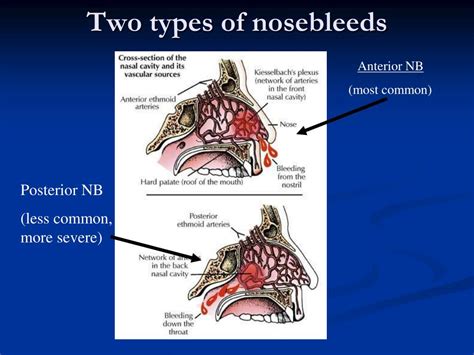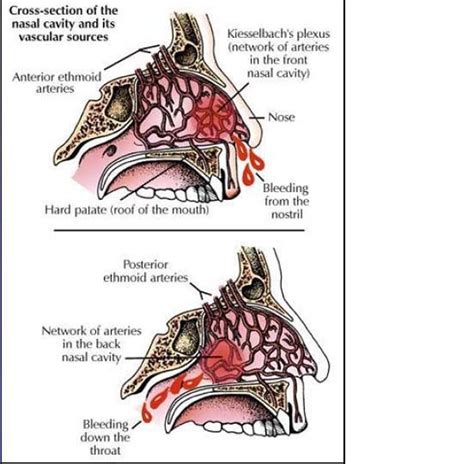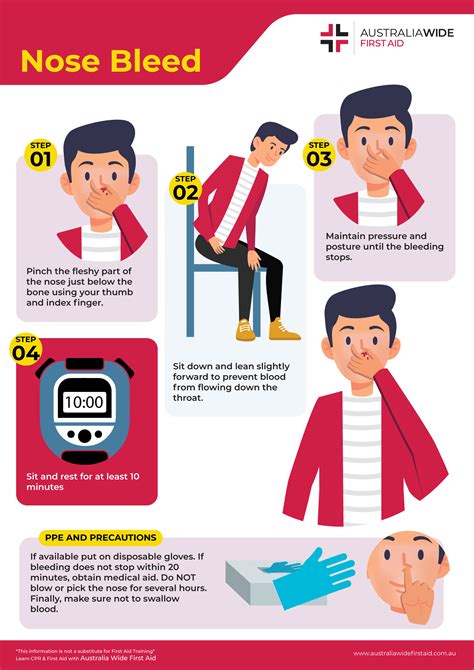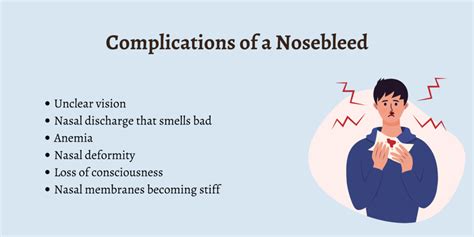Intro
Nosebleeds occur due to dry air, trauma, or allergies. Learn the common causes, including sinus pressure, colds, and nose picking, and discover how to prevent and treat them effectively.
Nosebleeds, also known as epistaxis, are a common condition that can occur in anyone, regardless of age or health status. They can be frightening, especially when they occur suddenly and without warning. Nosebleeds are characterized by bleeding from the nasal passages, which can be heavy or light, and may be accompanied by other symptoms such as nasal congestion, facial pain, or difficulty breathing. Understanding the causes of nosebleeds is essential to prevent and manage them effectively.
Nosebleeds can be caused by a variety of factors, including dry air, allergies, colds, and injuries. In some cases, nosebleeds can be a sign of an underlying medical condition, such as high blood pressure, bleeding disorders, or tumors. It is essential to identify the underlying cause of a nosebleed to provide appropriate treatment and prevent future episodes.
The nasal passages contain many small blood vessels that can easily become damaged, leading to bleeding. When the nasal mucosa, the lining of the nasal passages, becomes dry or irritated, it can crack and bleed. This is why nosebleeds are more common during the winter months when the air is dry and cold. Additionally, nosebleeds can be caused by blowing the nose too hard, picking the nose, or inserting objects into the nose, which can damage the delicate blood vessels and cause bleeding.
Types of Nosebleeds

There are two main types of nosebleeds: anterior and posterior. Anterior nosebleeds occur in the front part of the nose and are the most common type, accounting for about 90% of all nosebleeds. They are usually caused by dry air, allergies, or minor injuries, and can be treated with simple first aid measures. Posterior nosebleeds, on the other hand, occur in the back part of the nose and are less common. They are often more severe and can be caused by high blood pressure, bleeding disorders, or tumors.
Causes of Anterior Nosebleeds
Anterior nosebleeds are usually caused by minor injuries or irritations to the nasal mucosa. Some common causes of anterior nosebleeds include: * Dry air: Dry air can dry out the nasal mucosa, making it more susceptible to bleeding. * Allergies: Allergies can cause the nasal mucosa to become inflamed and irritated, leading to bleeding. * Colds: Colds and other respiratory infections can cause the nasal mucosa to become inflamed and irritated, leading to bleeding. * Blowing the nose too hard: Blowing the nose too hard can damage the delicate blood vessels in the nasal mucosa, leading to bleeding. * Picking the nose: Picking the nose can damage the delicate blood vessels in the nasal mucosa, leading to bleeding.Causes of Posterior Nosebleeds

Posterior nosebleeds are less common than anterior nosebleeds but can be more severe. Some common causes of posterior nosebleeds include:
- High blood pressure: High blood pressure can cause the blood vessels in the nasal mucosa to become weakened and more susceptible to bleeding.
- Bleeding disorders: Bleeding disorders, such as hemophilia, can increase the risk of nosebleeds.
- Tumors: Tumors in the nasal passages or sinuses can cause bleeding.
- Injuries: Injuries to the head or face can cause posterior nosebleeds.
- Infections: Infections, such as sinusitis, can cause posterior nosebleeds.
Symptoms of Nosebleeds
The symptoms of nosebleeds can vary depending on the severity and location of the bleeding. Some common symptoms of nosebleeds include: * Bleeding from the nose: This is the most obvious symptom of a nosebleed. * Nasal congestion: The nasal passages may become congested, making it difficult to breathe. * Facial pain: The face and nose may become painful and tender. * Swelling: The nose and face may become swollen. * Difficulty breathing: In severe cases, nosebleeds can cause difficulty breathing.Treatment of Nosebleeds

The treatment of nosebleeds depends on the severity and location of the bleeding. Some common treatments for nosebleeds include:
- Applying pressure: Applying pressure to the nose can help stop the bleeding.
- Using nasal decongestants: Nasal decongestants can help reduce nasal congestion and promote healing.
- Using saline nasal sprays: Saline nasal sprays can help keep the nasal mucosa moist and promote healing.
- Cauterization: In some cases, cauterization may be necessary to stop the bleeding.
- Surgery: In severe cases, surgery may be necessary to repair damaged blood vessels or remove tumors.
Prevention of Nosebleeds
Preventing nosebleeds is essential to avoid the complications and discomfort associated with them. Some common ways to prevent nosebleeds include: * Using a humidifier: Using a humidifier can help keep the air moist and reduce the risk of nosebleeds. * Avoiding blowing the nose too hard: Avoiding blowing the nose too hard can help prevent damage to the delicate blood vessels in the nasal mucosa. * Avoiding picking the nose: Avoiding picking the nose can help prevent damage to the delicate blood vessels in the nasal mucosa. * Using saline nasal sprays: Using saline nasal sprays can help keep the nasal mucosa moist and promote healing. * Managing allergies: Managing allergies can help reduce the risk of nosebleeds.Complications of Nosebleeds

Nosebleeds can be associated with several complications, including:
- Anemia: Severe or recurrent nosebleeds can lead to anemia.
- Infection: Nosebleeds can increase the risk of infection, especially if the bleeding is severe or recurrent.
- Scarring: Nosebleeds can cause scarring, especially if the bleeding is severe or recurrent.
- Difficulty breathing: Severe nosebleeds can cause difficulty breathing, especially if the bleeding is posterior.
When to Seek Medical Attention
It is essential to seek medical attention if you experience any of the following: * Severe bleeding: If the bleeding is severe or does not stop after 20 minutes of pressure. * Recurrent bleeding: If you experience recurrent nosebleeds. * Difficulty breathing: If you experience difficulty breathing. * Facial pain: If you experience severe facial pain. * Swelling: If you experience severe swelling.Conclusion and Next Steps

In conclusion, nosebleeds are a common condition that can be caused by a variety of factors, including dry air, allergies, and injuries. Understanding the causes and symptoms of nosebleeds is essential to prevent and manage them effectively. If you experience any of the symptoms mentioned above, it is essential to seek medical attention to prevent complications and promote healing.
What are the common causes of nosebleeds?
+Nosebleeds can be caused by dry air, allergies, colds, and injuries. They can also be caused by high blood pressure, bleeding disorders, or tumors.
How can I prevent nosebleeds?
+You can prevent nosebleeds by using a humidifier, avoiding blowing your nose too hard, and avoiding picking your nose. You can also use saline nasal sprays to keep the nasal mucosa moist and promote healing.
When should I seek medical attention for a nosebleed?
+You should seek medical attention if you experience severe bleeding, recurrent bleeding, difficulty breathing, facial pain, or swelling.
We hope this article has provided you with a comprehensive understanding of nosebleeds, their causes, symptoms, and treatment options. If you have any further questions or concerns, please do not hesitate to comment below or share this article with others who may benefit from it. Remember to always prioritize your health and seek medical attention if you experience any symptoms that concern you.
